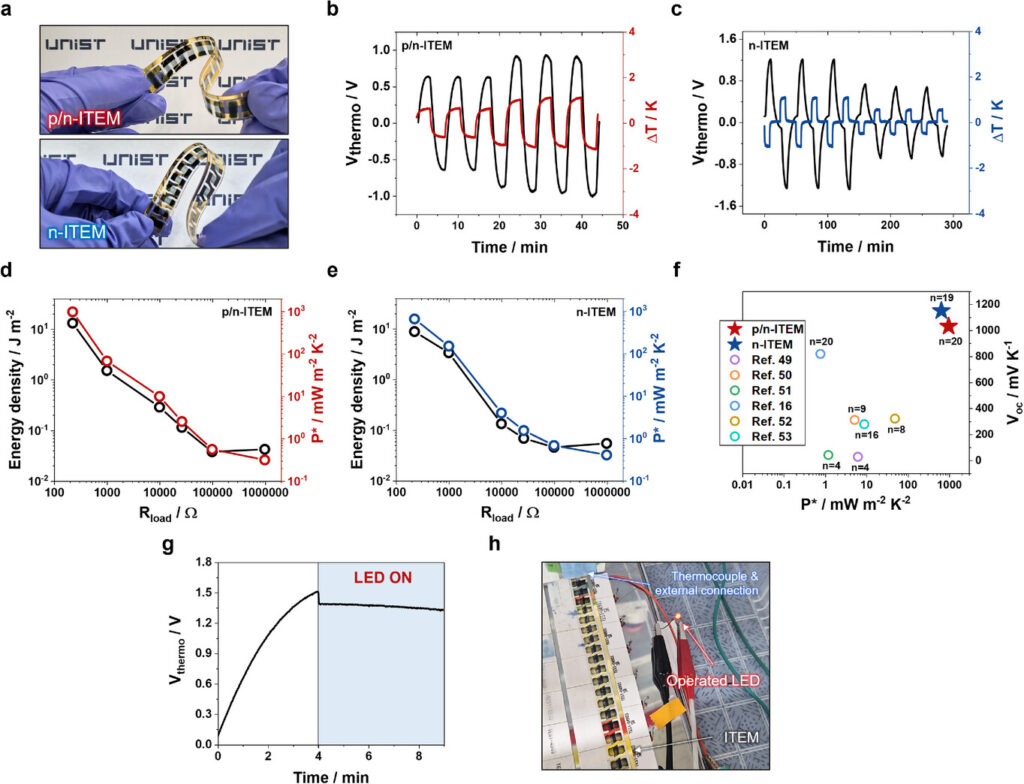Abstract
A research team, affiliated with UNIST has unveiled a novel thermoelectric (TE) film, capable of powering LED lights using a mere 1.5°C temperature difference between human body and ambient air. This innovative technology promies new possibilities for self-powered wearable devices and energy-harvesting applications.
Led by Professor Sung-Yeon Jang from the School of Energy Chemical Engineering at UNIST, the research team announced the development of a thermodynamically guided design strategy for high-performance ionic TE polymer complexes, achieving record-setting figures of merit for both p-type and n-type materials.
Functioning like tiny generators, TE materials convert temperature differences into electrical energy. In ionic TE systems, the movement of ions-protons (H⁺) in p-type and chloride ions (Cl⁻) in n-type materials-drives the generation of voltage. When a slight temperature gradient exists, these ions migrate and produce an electric current.
The new materials-comprising a flexible, polymer-based composite-achieve record-high ionic figures of merit (ZTi) of 49.5 for p-type and 32.2 for n-type, representing a 70% improvement over previous materials. Such high performance enables the generation of sufficient power from minimal temperature differences-less than 2°C-to operate electronic devices.
The p-type material is based on a conductive polymer composite, PEDOT:PSS, while the n-type incorporates copper chloride (CuCl₂) into the matrix. In operation, protons (H⁺) serve as charge carriers in the p-type, and chloride ions (Cl⁻) in the n-type. Both materials are lightweight, flexible, and easily fabricated into thin, film-shaped generators.
 Figure 1. Energy harvesting performance of the p/n-ITEM and n-ITEM.
Figure 1. Energy harvesting performance of the p/n-ITEM and n-ITEM.
In practical tests, a module composed of ten pairs of these p- and n-type films connected in series produced over 1.03 volts with just a 1°C temperature difference. Remarkably, this enabled a single LED bulb to light up with only a 1.5°C gradient. Long-term stability assessments confirmed the device maintained over 95% of its initial performance after more than two months of indoor operation.
The research attributes this performance to a systematic thermodynamic design strategy that optimizes the interplay between ion concentration and diffusion within the materials. By carefully analyzing and adjusting additive concentrations, such as CuCl₂, and internal polymer structures, the team identified conditions that maximize power density without hindering ion mobility.
Dong-Hu Kim, the lead author, explained, "Ionic TE materials have long lacked systematic design principles, which limited their full potential. Our work provides fundamental strategies to unlock their high-performance capabilities."
Professor Jang emphasized practical applications, "The newly developed materials are thin and flexible, allowing easy attachment to skin or curved surfaces. They can power wearable devices like smartwatches without batteries and enable self-powered sensors operating in environments with minimal temperature gradients."
The findings of this research were published online in Advanced Functional Materials on October 4, 2025. This research has been supported by the Ministry of Science and ICT (MSIT), the National Research Foundation of Korea (NRF), and through the InnoCORE program.
Journal Reference
Dong-Hu Kim, Bomin Kim, Jeong-Ye Baek, et al., "Thermodynamic Design Strategy for Ionic Thermoelectric Polymer Complexes with Giant Thermopower and Power Density," Adv. Funct. Mater., (2025).






